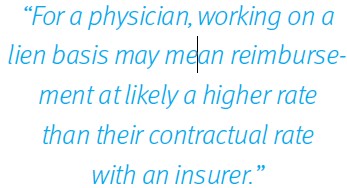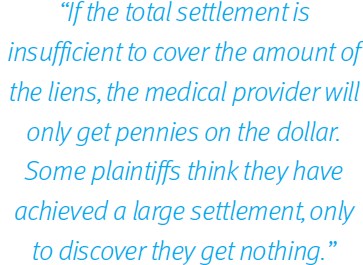Alan A. Ayers, MBA, MAcc
Urgent Message: The uncertain and extended payment cycle for treating personal injuries caused by third parties, which may be subject to litigation or settlement, can be managed using tools such as letters of protection and medical liens.
It’s not uncommon for an individual seriously injured in an accident or by medical negligence to bring a personal injury lawsuit against the at-fault party. If found liable, the at-fault party is held responsible for all damages caused by the accident, including medical bills. However, there’s usually a lag in the process of medical professionals being paid because “fault” is a finding of fact by a court that may stretch on for months or even years. As a result, most urgent care centers refuse to treat such patients, despite having the capability and capacity to do so.
Background
The typical personal injury case can take from a few months to several years to conclude.1 Most cases take an average of 12 to 14 months to resolve, but the timeline of a claim may depend on many varied factors. Nonetheless, the medical provider expects to be paid for the care they have rendered, and the patient is always responsible for their medical bills.
If the patient uses their health insurance, the provider is paid, but the health insurer will have subrogation rights against any future settlement in litigation. If the patient uses Medicare or Medicaid, the government can subrogate not only past bills but also future expected costs stemming directly from the injury. The government always has an automatic lien and first priority on any settlement.
But a medical provider may not want to continue treating a patient if they believe that they will not be paid. On the other hand, a patient will want to continue the care but may not be able to afford to pay the medical bills until their insurance claim is settled. In the meantime, the patient hires a personal injury attorney to settle or litigate with the insurance company. That process, again, can take time—all the while, no medical bills are being addressed.
A solution growing in popularity is what is know as a letter of protection. Financing companies that buy liens from doctors before litigation is complete are also becoming more common with the practice. And some healthcare providers treating personal injury victims are also agreeing to get paid only after a lawsuit is concluded. One author has noted that a “spate of legal and legislative changes has led to a proliferation of the practice in California and other states, including Florida, Colorado, Texas, and Georgia….”2 This article will examine this practice and what it means for healthcare providers.
What is a Letter of Protection?
A letter of protection is defined generally as promise from the injured person and his or her attorney to pay the physician at the conclusion of a personal injury case.3 In effect, it is an “IOU” for healthcare that is to be repaid at the end of the litigation.4 The plaintiff’s counsel issues a “letter of protection” to the doctor to enable care to continue, and the letter of protection assures that the provider will be paid from any future settlement.5
Also known as a type of medical lien, this is a legally binding agreement between a healthcare provider and a patient. This contract gives the healthcare provider the ability to recoup money owed for medical services by placing a lien on the patient’s personal injury claim.6 When the case comes to an end by jury verdict or by settlement, the healthcare provider exercises their rights according to the lien agreement and recovers the costs of healthcare they provided.
The Lien Process
Healthcare providers must “perfect the lien,” by sending notice of the bill to the at-fault party. For example, the statute in Missouri says that a lien is not effective without written notice containing the following:
- The name and address of the injured person
- The date of the accident
- The name and location of the medical practice
- The name of the person, firm, or corporation alleged to be liable to the injured party for the injuries received.7
This notice must be sent by certified mail with return receipt requested to the allegedly liable party or parties. The provider must also send a certified copy with return receipt requested to the insurance company that has insured the person, firm, or corporation, against such liability.7 As a result, provided the lien is properly asserted, when the check for the settlement or jury verdict is delivered to the plaintiff’s attorney, he or she must pay the healthcare provider the balance owed to them. But regardless of what happens in the settlement or at trial, the Missouri statute stipulates that the physician can only receive 50% of the balance of the settlement.7
Where Medical Liens are Recognized

While most states permit medical liens and letters of protection, several states do not. The hospital lien laws of 32 states provide that an attorney’s lien/fee takes precedent over the hospital lien.8 Six states have laws on the books that state that the hospital lien takes priority over all other liens.8 Some states, such as Vermont, provide that the hospital lien cannot take more than two-thirds of the total third-party settlement or $500, whichever is lesser, after attorneys’ fees.9
In addition, there are states that subordinate a physician’s or dentist’s lien and cannot claim more than 25% of the third-party recovery remaining after a hospital lien has been repaid. However, even in the 9 states that do not allow this practice by statute, settlement liens are still permitted under common law theories of equity. Even so, it is important to note that state legislatures are keeping a close eye on this issue and many are acting. For example, the Florida Legislature addressed past medical expenses and letters of protection this year as part of a tort reform bill.10
Analysis
A primary benefit of using a lien is that it can provide an uninsured patient with access to a higher quality of healthcare. And for a physician, working on a lien basis may mean reimbursement at likely a higher rate than their contractual rate with an insurer.11
But not all physicians accept liens as a basis for payment, as the biggest risk for physicians is that the plaintiff will not be successful in the lawsuit or receive a sizable settlement, and, as a result, the provider will be uncompensated or will be undercompensated. If the total settlement is insufficient to cover the amount of the liens, the medical provider will only get pennies on the dollar. Some plaintiffs think they have achieved a large settlement, only to discover they get nothing because the lion’s share will go their attorney and doctors.
In addition, it is important to note that there is a significant difference between insured and uninsured accident victims. In most instances, the state imposes a limit on the amount an insurer can recoup from the settlement money; however, there is typically no such limit on liens. Also, with insurance, subrogation is usually a component of the insurance policy which provides that the insurer has the right to collect damages on behalf of the other party (in this case, the plaintiff). As such, it is a way for the insurance company to recoup its losses.
Again, as mentioned above, physicians cannot be sure that they will be paid the entire portion of the bill for their services. Plus, providers must wait as long as year or longer for the resolution of a plaintiff’s case.12
In addition, if the accident victim loses the case, he or she will be liable for all of their healthcare expenses and will need to pay them at some point. They will still owe a considerable sum to the healthcare provider and will be personally responsible for paying it in total. It is possible for the healthcare provider to enforce their legal rights and take the patient to court or collections.12

Due to the range of presentations that could be considered “personal injury” there is not separate published data as to the percent of urgent care centers that accept such patients. Anecdotally, “corporatized” chains, staffed by advanced practice providers, are most likely to refer such patients to the emergency department due to risk associated with the acuity of the injury, the lack of available follow-on care, and the complexities of payment, whereas an independent, physician-owned and -operated urgent care, especially one with sizable workers compensation volume, pain management, and/or physical therapy services, is more likely to treat the injury.
According to the Urgent Care Association, 7% of urgent care visits are for work-related injuries.13 What’s the difference? Generally, a personal injury claim is concerned with who’s at fault, but when a similar injury occurs at work, the concern is with whether the injury occurred on the clock and in the course of one’s employment. Workers compensation thus provides “no fault” coverage. Whereas damages in a personal injury claim may be punitive, expansive to emotional distress and other damages, workers compensation is limited to medical and lost wages. Workers compensation rules are generally defined by statute and administered by the Industrial Commission of each state.
Summary
While there are legal arrangements for urgent care providers to be paid for personal injury cases, and some can result in higher fees for physicians than they would receive from health insurance, there is complication in collections and delay in payment as well as the risk it can expose victims to large bills if their lawsuits fail.12
References
- How Long Will My Injury Claim Take? Ejuris. Retrieved at https://www.enjuris.com/personal-injury-law/injury-claim-process-timing/. Tort trials reached a verdict 25.6 months from the date the lawsuit was filed. Id.
- Sara Randazzo, Who Wins in a Personal-Injury Lawsuit? It Can Be the Doctor. Wall St. J (January 8, 2020). Retrieved at https://www.wsj.com/articles/who-wins-in-a-personal-injury-lawsuit-it-can-be-the-doctor-11578479400.
- Wade B. Coye, What Is A Letter Of Protection? HG.org. Retrieved at https://www.hg.org/legal-articles/what-is-a-letter-of-protection-learn-more-about-the-pros-and-cons-of-using-a-letter-of-protection-or-lop-47082. Fla. Stat. § 768.0427(d). See Gray v. USAA Cas. Ins. Co., No. 8:21-cv-728-SPF, 2023 U.S. Dist. LEXIS 70176, at *5 n.1 (M.D. Fla. Apr. 21, 2023)
- See S. Kyle Weaver, The War on Civil Defendants in Florida: Where We Are, How We Got Here, How to Fix It, and Why It Matters, 52 Cumb. L. Rev. 391, 412 (2021-2022).
- See Anthony J. Sebok, The Rules of Professional Responsibility and Legal Finance: A Status Update, 57 Wake Forest L. Rev. 777, 809 (Fall 2022).
- What Is A Medical Lien – Everything You Need To Know, Medical Billing Analysts (July 25, 2022). Retrieved at https://www.medicalbillinganalysts.com/what-is-a-medical-lien-everything-you-need-to-know.
- Mo. Stat. § 430.240.
- See Gary L. Wickert and Mark A. Solomon, Zen And The Art Of Hospital Lien Maintenance, Matthiesen, Wickert & Lehrer, S.C. (September 16, 2019). Retrieved at https://www.mwl-law.com/hospital-lien-maintenance/.
- 18 V.S.A. § 2251.
- See Torres-Aponte v. Hudnall, 2023 Fla. Cir. LEXIS 1051, *4 (13th Jud. Cir., Hillsborough Cnty, July 18, 2023).
- See George A. Nation III, The Valuation of Medical Expense Damages in Tort: Debunking the Myth That Chargemaster-Based “Billed Charges” Are Relevant to Determining the Reasonable Value of Medical Care, 95 Tul. L. Rev. 937 (April 2021). See also George A. Nation III, Hospital Chargemaster Insanity: Heeling the Healers, 43 Pepp. L. Rev. 745, 748 (2016).
- Ciara Chambers and Liz LaFoe, Legality and Ethics of Lien Uses in Medicine, 117(4) Mo Med 313–318 (July-August 2020).
- Urgent Care Association. Urgent Care Industry Whitepaper. August 17, 2023. https://urgentcareassociation.org/urgent-care-industry-white-paper/ Accessed February 27, 2024.
Author Affiliation: Alan A. Ayers, MBA, MAcc, is President of Experity Consulting and is Senior Editor of The Journal of Urgent Care Medicine.
Read More
- Getting Served: The Do’s And Don’ts Of Litigation
- Urgent Care Operator’s Liability For A Car Crash Into The Center
- How To Recognize And Handle Potentially Litigious Patients

